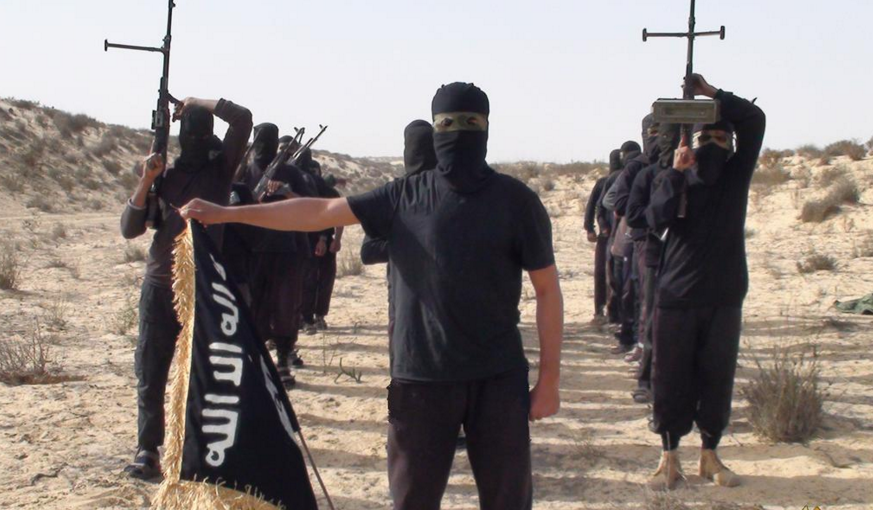by Theodore Karasik and Giorgio Cafiero
At the beginning of January, the offshoot of the Islamic State (ISIS or IS) in the Egyptian Sinai released a 22-minute execution video titled “Community of Abraham.” The victim was an alleged Hamas collaborator. The video was IS’s declaration of war against Hamas in Gaza. The narrator accused Hamas of preventing IS loyalists from migrating to the Sinai from Gaza and called on IS adherents to “use explosive, silenced pistols, and sticky bombs” to “bomb [Hamas] courts and their security locations, for these are the pillars of tyranny that prop up its throne.”
Hardline Salafist-jihadist militias that challenge the legitimacy of Hamas are not new to Gaza. Such extremist groups began to emerge in the 2000s. These factions—once mainly affiliated with al-Qaeda (such as the Mujahideen Shura Council in the Environs of Jerusalem and Jaljalat) and later with IS (such as Supporters of Islamic State in Jerusalem)—have recruited from disaffected Hamas members. These defectors concluded that the Palestinian resistance group had abandoned certain principles by receiving support from Iran and Lebanese Hezbollah, participating in elections, and agreeing to ceasefires with Israel.
Over the years these extremist militias have launched attacks from Gaza against Israel and created difficult dilemmas for Hamas. Although Hamas had nothing to do with such violence, Israeli authorities have consistently held Hamas accountable and launched retaliatory strikes against the group. When such attacks are carried out at times that Hamas deems to be strategically unsound, the Palestinian group has chosen to prevent such attacks despite risking a backlash from Gazans who perceive Hamas as undermining the resistance.
Hamas has indeed cracked down on IS loyalists in Gaza and arrested hundreds of them. This is another likely reason why IS is increasingly focused on fighting Hamas at this juncture. Hamas also raised the ire of IS when it sent a delegation to Egypt in September 2017 for talks with the Abdel Fatah el-Sisi regime, which is at war with IS in the Sinai. At the same time, the rapprochement between Hamas and Iran, following tensions connected to the Syrian civil war, has added more momentum to the IS quest to topple Hamas from power in Gaza, especially as the Iranian-backed Syrian Arab Army continues bombing Salafist-jihadist forces in Idlib.
At the heart of IS hatred of Hamas is the latter’s tendency to embrace political pragmatism over ideology. As the entity with administrative authority in Gaza, Hamas is not only responsible for waging an armed struggle against Israel but also for providing public services for the enclave’s two million besieged and malnourished inhabitants. Economic circumstances and geographic realities have pressured Hamas into accepting support from Iran and Qatar while seeking a more cordial relationship with Egypt to secure a flow of imports into Gaza. Outside of the Middle East, Hamas has established positive relationships with China, Norway, Russia, and Switzerland, which IS finds ideologically unacceptable.
Also, Hamas has in principle agreed to a permanent ceasefire with the Jewish state in line with the Arab Peace Initiative. Thus, since Hamas’s end goal is the establishment of a Palestinian state, the group’s nationalist agenda clashes with IS, which opposes any recognition of Israel. Moreover, the formation of a Palestinian state is not a political goal of IS, which fights under the umbrella of a pan-Islamic ideology that IS accuses Hamas of abandoning.
As illustrated by the message in the Sinai-based IS offshoot’s recent execution video, the status of Jerusalem is an issue that IS is embracing to spread its anti-Hamas narrative. Seeking to capitalize on rage felt in Gaza and other parts of the Arab/Muslim world over President Donald Trump’s recognition of Jerusalem as the Israeli capital in late 2017, IS is accusing Hamas of failing to take an adequately strong position against Trump’s decision while attempting to cozy up to Western powers.
Since hardline Salafist-jihadist militias entered Gaza’s security environment in the 2000s, Hamas has effectively suppressed their activities. Given the size of Hamas’ police and armed wing, IS has an extremely low probability of toppling the Hamas leadership in Gaza and establishing totalitarian rule in the besieged coastal enclave.
Nonetheless, IS still poses a significant threat to Hamas. Despite lacking the numbers to overthrow the administrative authority in Gaza, IS loyalists can still fuel instability in the strip through stepped-up terror attacks not only against Israel but also against Hamas. Such attacks would come on top of the challenges Hamas faces from Israel and from providing services to two million Palestinians in an area where the UN forecasts that by 2020 the only water source will be “irreversibly depleted.”.
Israel and IS share an interest in weakening both Hamas and Palestinian Islamic Jihad, though for entirely different reasons. Hamas, however, has popularized a narrative of Israel-IS collusion in Gaza. Though primarily rooted in speculation and hearsay, such a narrative helps Hamas portray Salafist-jihadist groups as guilty of deepening intra-Palestinian divisions and “distorting the resistance” against Israel. How the Hamas-IS rivalry for legitimacy in Gaza plays out in the hearts and minds of Gazans remains to be seen. But as conditions in Gaza remain dire, more Palestinians in the coastal enclave may join IS out of dissatisfaction with Hamas’s governance and its strategies for resisting Israel.
Theodore Karasik is a senior advisor at Gulf State Analytics. Photo: Islamic State in the Sinai






And so the conservative Saudi’s have once again spread terror yet the focus is on Iran exclusively. Wonder what will happen when people wake up?
The US/Saudi force created to change the Middle East has failed in Iraq and Syria, thanks to Russia and Iran as well as to Iraq and Syria, so the “IS” forces are being shuffled elsewhere, Afghanistan and Gaza and probably to China and Russia too in an attempt to advance US objectives.
Unfortunately the author is trying to pass on to us the crappy disinformation that Mossad has given to him! You should investigate the info further! It is common knowledge that ISIS is put together by the triangle, US, Israel and Saudi, to protect Israel’s illegal territorial claims! This happened in Syria around Golan Heights and they were decimated and now penetrating the Palestinians’ homes in Gaza to provide excuses to Israel for further bombing of Hamas and poor Palestinians! Mossad May have fooled you but it’s more challenging for you to pass on a lie to us!